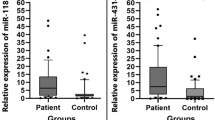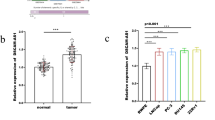Abstract
Many studies informed that microRNAs (miRNAs) could function as diagnostic and prognostic indicators in several cancers. The aims of this study were to explore the expression of miR-630 in bladder urothelial carcinoma and its clinical significance for the evaluation of cancer prognosis. A total of 116 patients with bladder urothelial carcinoma were obtained in this retrospective study between May, 2012 and Sep. 2015. Quantitative real-time PCR (qRT-PCR) was conducted to evaluate the expression level of miR-630. The chi-square test was used to examine the associations between miR-630 expression and the clinicopathological features. The Kaplan-Meier method was conducted to explore the survival status of urothelial carcinoma patients. The log-rank test was used to analyze differences in survival rate. The results showed an obvious increase in miR-630 expression from normal bladder to bladder urothelial carcinoma (P=0.027). Additionally, patients with higher miR-630 expression had significantly shorter disease-free survival (DFS) (P=0.043) and overall survival (OS) (P=0.038) than those with lower miR-630 expression. Furthermore, multivariate analysis revealed that up-regulation of miR-630 was an independent prognostic factor for both DFS (P=0.042) and OS (P=0.046). It was demonstrated that miR-630 may be a novel and valuable prognostic factor for bladder urothelial carcinoma.
Similar content being viewed by others
References
Lopez-Beltran A. Bladder cancer: clinical and pathological profile. Scand J Urol Nephrol Suppl, 2008,218(9):95–109
Kaufman DS, Shipley WU, Feldman AS. Bladder cancer. Lancet, 2009,374(9685):239–249
Van der Aa MN, Steyerberg EW, Sen EF, et al. Patients’ perceived burden of cystoscopic and urinary surveillance of bladder cancer: a randomized comparison. BJU Int, 2008,101(9):1106–1110
Yu WF, Wang HM, Lu BC, et al. miR-206 inhibits human laryngeal squamous cell carcinoma cell growth by regulation of cyclinD2. Eur Rev Med Pharmacol Sci, 2015,19(14):2697–2702
Sun K, Lai EC. Adult-specific functions of animal microRNAs. Nat Rev Genet, 2013,14(8):535–548
Khare S, Zhang Q, Ibdah JA. Epigenetics of hepatocellular carcinoma: role of microRNA. World J Gastroenterol, 2013,19(33):5439–5445
Galluzzi L, Morselli E, Vitale I, et al. miR-181a and miR-630 regulate cisplatin-induced cancer cell death. Cancer Res, 2010,70(5):1793–1803
Chu D, Zhao Z, Li Y, et al. Increased microRNA-630 expression in gastric cancer is associated with poor overall survival. PLoS One, 2014,9(3): e90526
Sauter G, Algaba F, Amin M. Tumor of urinary system: non-invasive urothelial neoplasia. In: Eble JN, Sauter G, Epstein JI, et al, editors. Pathology and genetics of tumours of the urinary system and male genital organs. Lyon: IARCC Press, 2004
Sobin LH, Gospodariwicz M, Wittekind C. TNM classification of malignant tumors. UICC International Union against cancer. 7th ed. New Jersey: Wiley-Blackwell, 2009,262.
NICE Guideline, Bladder Cancer: Diagnosis and Management, National Institute for Health and Care Excellence (NICE), London, UK, 2015
Clark PE, Agarwal N, Biagioli MC, et al. Bladder cancer. J Natl Compr Cancer Netw, 2013,11(4):446–475
Kwak PB, Iwasaki S, Tomari Y: The microRNA pathway and cancer. Cancer Sci, 2010,101(11):2309–2315
Iorio MV, Croce CM. MicroRNA dysregulation in cancer: diagnostics, monitoring and therapeutics. A comprehensive review. EMBO Mol Med, 2012,4(3):143–159
Yanokura M, Banno K, Kobayashi Y, et al. MicroRNA and endometrial cancer: Roles of small RNAs in human tumors and clinical applications (Review). Oncol Lett, 2010,1(6):935–940
Farhana L, Dawson MI, Murshed F, et al. Upregulation of miR-150* and miR-630 induces apoptosis in pancreatic cancer cells by targeting IGF-1R. PLoS One, 2013,8(5):e61015
Corcoran C, Rani S, Breslin S, et al. miR-630 targets IGF1R to regulate response to HER-targeting drugs and overall cancer cell progression in HER2 over-expressing breast cancer. Mol Cancer, 2014,13(3):71
Cao JX, Lu Y, Qi JJ, et al. MiR-630 inhibits proliferation by targeting CDC7 kinase, but maintains the apoptotic balance by targeting multiple modulators in human lung cancer A549 cells. Cell Death Dis, 2014,5(25):e1426
Zou YT, Gao JY, Wang HL, et al. Downregulation of microRNA-630 inhibits cell proliferation and invasion and enhances chemosensitivity in human ovarian carcinoma. Genetics and molecular research: GMR, 2015,14(3):8766–8777
Rupaimoole R, Ivan C, Yang D, et al. Hypoxia-upregulated microRNA-630 targets Dicer, leading to increased tumor progression. Oncogene, 2016,35(33):4312–4320
Chu D, Zheng J, Li J, et al. MicroRNA-630 is a prognostic marker for patients with colorectal cancer. Tumour Biol, 2014,35(10):9787–9792
Zhao JJ, Chen PJ, Duan RQ, et al. Up-regulation of miR-630 in clear cell renal cell carcinoma is associated with lower overall survival. Int J Clin Exp Pathol, 2014,7(6):3318–3323
Zhao JJ, Chen PJ, Duan RQ, et al. miR-630 functions as a tumor oncogene in renal cell carcinoma. Arch Med Sci, 2016,12(3):473–478
Gu L, Li H, Chen L, et al. MicroRNAs as prognostic molecular signatures in renal cell carcinoma: a systematic review and meta-analysis. Oncotarget, 2015, 6(32):32545–32560
Asgari MA, Safarinejad MR, Shakhssalim N, et al. Quality of life after radical cystectomy for bladder cancer in men with an ileal conduit or continent urinary diversion: a comparative study. Urol Ann, 2013,5(3):190–196
Author information
Authors and Affiliations
Corresponding author
Additional information
This project was supported by National Science Council, aiming for the Top University Plan, of China (No. 81100464).
Rights and permissions
About this article
Cite this article
Wang, Zy., Zhang, W., Yang, Jj. et al. Expression of miRNA-630 in bladder urothelial carcinoma and its clinical significance. J. Huazhong Univ. Sci. Technol. [Med. Sci.] 36, 705–709 (2016). https://doi.org/10.1007/s11596-016-1648-x
Received:
Revised:
Published:
Issue Date:
DOI: https://doi.org/10.1007/s11596-016-1648-x




